P-8 FOR SAFE MACHINE OPERATION PARA UNA UTILIZACIÓN SEGURA DE LA MÁQUINA
ATENCION
10. Bolts used for fixtures should be periodi-
cally replaced with the bolts specified by
Mori Seiki that have appropriate strength.
[Bolt breakage/Workpiece, fixture, cutting
tool ejection/Serious injuries/Machine dam-
age]
11. Ensure workpiece, cutting tool, holder, soft
jaws, and tailstock (if installed) are tight-
ened securely.
[Workpiece, cutting tool ejection]
12. Machining conditions such as depth of cut
or feedrates must be set in stages with suf-
ficient leeway during test cutting.
[Workpiece, cutting tool ejection]
13. Do not place hands or feet inside the chip
conveyor (if installed) during operations.
[Entanglement]
14. Stop the machine and coolant supply
before removing chips or adjusting the
direction or volume of the coolant supply.
[Entanglement]
15. Remove the workpiece from the machine
before deburring it by hand.
[Entanglement/Injury]
16. Always work at a safety margin of at least
20 cm from the window. This impact resis-
tant window could be substantially
deformed to ease the impact of an ejected
tool, or could break if struck very hard.
[Injury]
17. When using the stopper inside the spindle,
confirm the adjusting shaft does not pro-
trude excessively from the rear of the spin-
dle.
[Shaft ejection during spindle rotation]
18. When operating a machine equipped with a
hollow chuck, install the attached through
hole cover to the chuck if the through hole
is not used.
[Chuck, cylinder or other hydraulic circuit
malfunction due to entry of coolant or
chips]
19. Contact the Mori Seiki Service Department
before grinding.
[Grinding stone and cover breakage]
20. Optional specifications machines must be
operated in compliance with such specifica-
tions.
10. Los pernos empleados para los dispositivos de
fijación deberían reemplazarse periódicamente con
aquellos pernos recomendados por Mori Seiki que
tengan la fuerza apropiada.
[Rotura de perno/eyección de pieza, dispositivos de
fijación, herramienta de corte/lesiones graves/
desperfectos en la máquina]
11. Compruebe que la pieza, la herramienta de corte, el
soporte, las mordazas y el contrapunto (en caso de
estar instalado) estén bien apretados.
[Eyección de pieza, herramienta de corte]
12. Las condiciones de mecanizado como la
profundidad de corte o la velocidad de avance
deberán configurarse por etapas y con una
tolerancia suficiente durante el corte de prueba.
[Eyección de pieza, herramienta de corte]
13. No coloque sus pies o manos en el transportador de
virutas (si está instalado) durante el funcionamiento
de la máquina.
[Enredo]
14. Detenga la máquina así como el suministro de
refrigerante antes de extraer las virutas o de ajustar
la dirección o el volumen del suministro de
refrigerante.
[Enredo]
15. Retire la pieza de la máquina antes de realizar el
desbarbado a mano.
[Enredo/lesión]
16. Trabaje siempre con un margen de seguridad de al
menos 20 cm de separación de la ventana. Esta
ventana resistente a impactos podría resultar
considerablemente deformada al recibir el impacto
de una herramienta eyectada, o podría romperse si
se golpeara con fuerza.
[Lesión]
17. Cuando utilice el obturador dentro del husillo,
compruebe que el eje de ajuste no sobresalga
excesivamente de la parte trasera del husillo.
[Eyección del eje durante la rotación del husillo]
18. Cuando maniobre una máquina equipada con un
plato hueco, instale en el plato la cubierta pasante
adjunta si no se utiliza el agujero pasante.
[Mal funcionamiento del plato, del cilindro u otros
circuitos hidráulicos debido a la entrada de
refrigerante o virutas]
19. Póngase en contacto con el el servicio de asistencia
de Mori Seiki antes de realizar una operación de
amolado.
[Ruptura de cubierta y piedra de amolar]
20. Las máquinas con especificaciones opcionales
deben utilizarse de acuerdo con dichas
especificaciones.

